We came in peace from all of humanity

July 20, 1969 at 20:17:39 UTC, which at that time was called Greenwich, the lunar module Eagle of the Apollo-11 spacecraft made a soft landing on the lunar surface. Upon returning to Earth on July 24, 1969, the crew (commander Neil Armstrong, lunar module pilot Baz Aldrin and pilot of the command / service module Michael Collins) was sent to quarantine for two weeks. Right on the deck of the aircraft carrier, the astronauts underwent complete, biological isolation in case they brought extraterrestrial microorganisms with them. The heroes of the first lunar expedition were kept in a special box of the Lunar Reception Laboratory in Houston, until it became clear that their health was in perfect order. Stepping out from behind the glass (see photo below), on August 12, 1969, the Apollo 11 crew gave the first press conference. Punctilious speculators speculate on it, claiming that the astronauts were constrained, nervous, confused, etc.
Apparently, this press conference was never published in Russian. In addition, the original, magnetic recording was distorted before it was digitized. Therefore, the sample stored on the NASA website is not completely authentic, although it is very close to this. About a month later, on September 16, 1969, a transcript was published, which is also not entirely accurate.
All this would not have been of the slightest significance (and had not had it until recently) if in the 21st century the paranoid desire to challenge the reality of the Apollo program had not spread across the Internet like a pandemic. Apparently, the majority of patients with lunar conspiracy theories live in Russia, if you count per capita. The problem is compounded by the fact that the subtitles that are found in video copies of the press conference contain a fatal number of errors. This may be due to machine speech recognition errors, but it cannot be ruled out that moonwrestlers intentionally load warped subtitles.
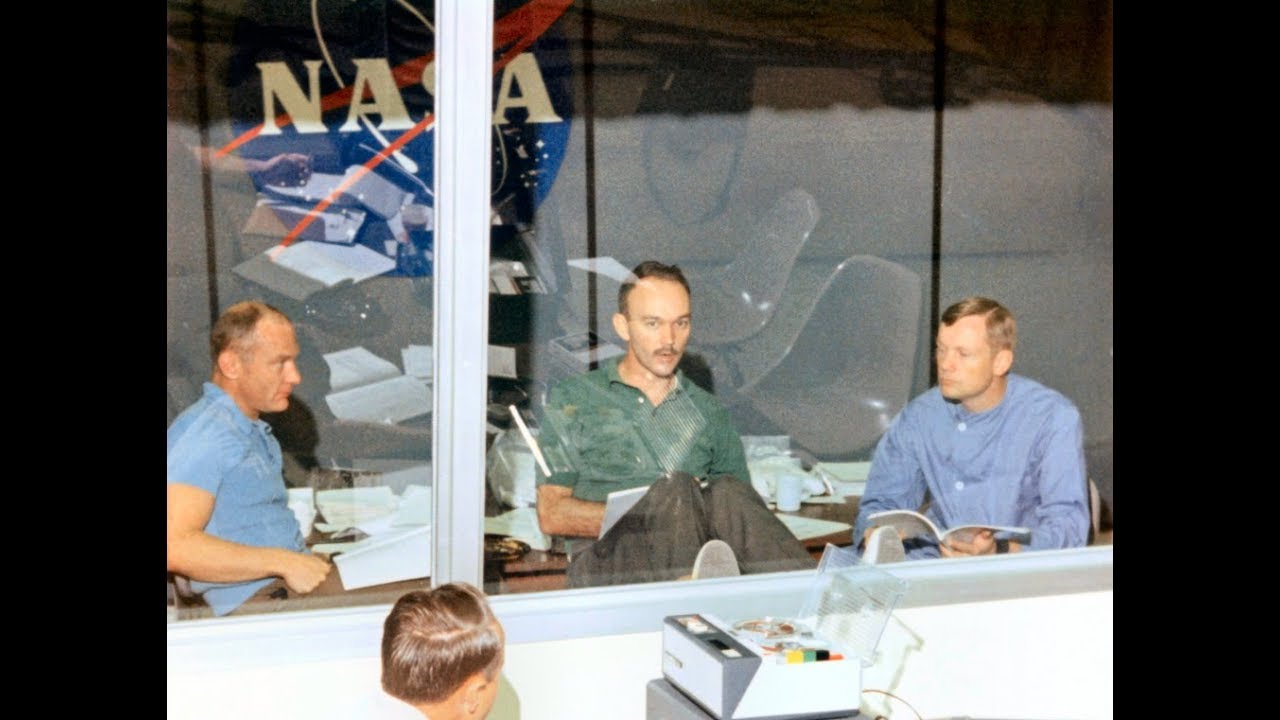
Quarantine crew Apollo-11, Lunar Receiving Laboratory.
This publication provides a completely authentic translation into Russian of the Apollo 11 press conference of August 12, 1969. I had to translate its English transcript, which helped Google a lot, and also listened carefully to the recording on the NASA website. Given the defects noted above, it was also necessary to compare different copies of magnetic recordings. The result of these efforts is presented to readers.
Those who speak the North American language fluently, please do not judge too harshly, because the purpose of this publication was to expose the fantasies and lies of the martial artists, and not to demonstrate my (humble) knowledge in this language. The text is accompanied by comments in italics . Everything else (direct font), starting from the next paragraph, is taken from the official transcriptwww.hq.nasa.gov/alsj/a11/a11PostFlightPressConf.html and videos of the Apollo-11 crew press conference.
At 10 a.m. CDT, on August 12, 1969, Julian Scheer, NASA's Assistant Administrator for Public Relations, opened a television press conference on Apollo 11 in the audience of the Manned Spacecraft Center, Houston, Texas. Addressing about two hundred media representatives from the United States and other countries, he said:
"Ladies and Gentlemen. Welcome to the Manned Spacecraft Center. This is the Apollo 11 press conference. Today's format will consist of a 45-minute presentation from the Apollo 11 crew, followed by questions and answers. At the moment, I would like to introduce the crew of Apollo 11, astronauts Neil Armstrong, Michael Collins and Edwin Aldrin Jr. ”
Neil Armstrong, the commander of Apollo 11, began a report to the whole world about the epic journey of Orel and Colombia to the Moon and back to Earth.
This flight began on July 16 at 9:32 a.m. east time, when the Saturn 5 rocket launched Apollo 11 into low Earth orbit from Cape Kennedy. Having made a half revolution around the Earth, the third stage of Saturn V turned on the engine again to send Apollo on a journey to the moon. Soon after, the Columbia command / service module separated from Saturn’s third stage, turned around and docked nose to nose with the Eagle lunar module, which was inside the third stage. With the Eagle attached to the bow, Columbia moved away from the third step and headed for the Moon.
On July 19, Apollo 11 approached and went beyond the moon. At 1:28 p.m. EDT, he turned on the service module engine to enter lunar orbit. After 24 hours in orbit, Armstrong and Aldrin separated Eagle from Colombia to prepare for the descent to the surface. July 20 at 4:18 in the afternoon the lunar module landed on the Moon at the Base of Tranquility. Armstrong said: "The eagle has sat down." And at 10:56 p.m. Armstrong, going down the stairs of the Eagle and touching with one foot the surface of the Moon, announced:
“This is one small step for man and one giant leap for mankind.”
Soon Aldrin joined Armstrong. They carried out their planned tasks in front of a television camera, which they installed on the lunar surface.
Man’s first dramatic adventure on the moon ended on July 21 at 1:54 pm when Armstrong and Aldrin rose from the moon in a tower of flame. They annexed Eagle to Colombia, in which Collins was waiting for them in lunar orbit. They returned to Colombia and allowed the Eagle to sail freely.
Then the astronauts turned on the engine of the service module to break out of the gravitational arms of the moon and go home. They reached the Earth’s environs at a speed of about 25,000 miles per hour, as if they entered the atmosphere in such a way as to avoid burning or bouncing back into space, and finally, with open parachutes, they splashed down in the Pacific Ocean to the southwest of Hawaii on July 24 at 12: 51 in the afternoon.
This text is a transcript of the Apollo 11 post-flight press conference. This is a description of the first ever trip to another celestial body made by the people who performed it.
ARMSTRONG:
We were happy to participate in one great adventure. This adventure took place not so much in July as in the last decade. All of us here and people listening to the radio today had the opportunity to share this adventure in the process of its development and deployment in recent months and years. Today we are honored to share with you some of the details of this final July, which has definitely become the highlight of this decade for the three of us.
We are going to deviate a bit from the format of past press conferences and tell you about the things that interested us the most and especially about what happened on the moon and around it. We use several films and slides that most of you have already seen, with the intention of noting some things that we observed on the spot and that may not be obvious to those of you who are watching them from the surface of the Earth.
The flight, as you know, started exactly, and I think that was characteristic of all the events of this flight. Saturn made one magnificent walk, into the orbit of the Earth and the trajectory to the moon (Photo 1). Our memories of this actually do not differ much from those reports that you heard about previous flights of Saturn V, and previous flights have served us well in preparing for this both in the take-off stage and in the subsequent stages. We would like to immediately proceed to the phase of the translunar swimming and recall the chain of events - that long chain of events - which actually made this landing possible, starting with undocking, rearrangement and docking (lunar and command / service modules) .
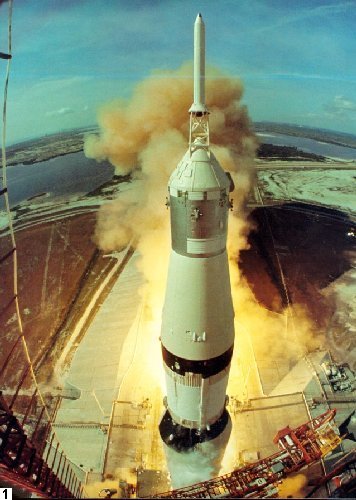
COLLINS:
This was our first look at the magnificent technique, which until this moment was located behind us. The rocket carrier, of course the first and second stages, has long been separated, but it shows the LM (lunar module), located inside the third stage (S-4B) after the transition to the translunn’s orbit (Photo 2). This maneuver was an interesting combination of manual and automatic actions, for which we programmed the on-board computer to make a coup. And then these final maneuvers were done entirely by hand.
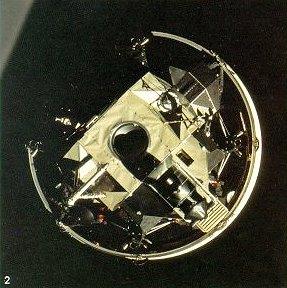
While I was approaching LM, everything was simple because I had a docking target (Photo 3), which is not very visible here, which allowed me to align the probe and the docking anchor, which is a dark spot that you see in the upper right. During this time, I also checked the correctness of the ship's response to the control actions of my joystick. Soon you will see a real dock in a somewhat accelerated form. This is the moment of contact and exactly in a second you will see ... here ... a second indication of the retraction cycle when 12 docking locks have worked.

By the coup, Collins meant turning the command / service module 180 degrees around the transverse axis in order to dock with the lunar module in the new position (the lunar module is designated LM everywhere further) and pull it out of the 3rd stage. After that, the ship once again turned over 180 degrees.
Aldrin:
We made two entries into the lunar module (LM). This is our first look at it from the inside (Photo 4). Final activation was carried out on the day of the controlled descent (to the moon). On the previous two days, when we entered the LM, we removed the docking probe and anchor and found that we had a rather long tunnel between the two ships. At the entrance to the lunar module, it was necessary to perform the reverse half-somersault forward, since the lunar module, of course, is in a sense turned upside down relative to the command module.
By two ships, Aldrin meant the lunar module "Eagle" and the command + service modules under the general name "Columbia", all together it amounted to "Apollo 11".
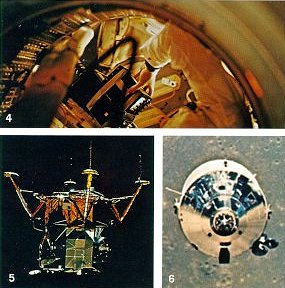
COLLINS:
This is in the lunar orbit ... separation of the lunar module from the command module, as was seen from my window (Photo 5). It was a busy time for me, during which I shot this film through the right window and at the same time took photos through the left window and also controlled my ship ... probably bad (Collins jokes) and carefully watched LM while it turned over. My most important job here was to make sure that all of his landing poles were released and correctly locked before the descent and landing.
This is his scouring maneuver ... the white spots you see are the pillows of the landing supports. This gives you a better idea of the details available at 70 millimeters. Here LM is shown in the correct position or upside down, I'm not sure which one. From this point of view, in my opinion, it looks more like a mantis than a first-class aircraft, but it was a great example of technology. The landing poles are on top, and you can see the probes that capture the moment of contact with the moon, like thin wires going up from the landing poles.
Speaking of the details available at 70 millimeters, Collins apparently sneered at the low resolution of the 16 mm film on which the lunar expeditions were filmed. But it is obvious that only such a film, besides specially developed by Codac, was sufficiently resistant to cosmic radiation.
Aldrin:
Of course, before we could undock, as shown in this picture, we had to complete activation (LM) . The day before we undocked, we entered the LM and went through a complete check of the position of the switches and we practiced with various communication modes. Looking back, since we still had a slight communication problem during the guided descent, we would recommend that we can conduct a more thorough check of this the day before the descent.
That day, when we finally entered the LM for a landing maneuver, we went through a divided sequence of putting on spacesuits and found that thanks to the simulations we worked here in Houston or with Houston related to our imitations on the Cape (Canaveral), we were We are quite confident that we will be able to complete the activation of LM in a given period of time (which was approximately 4 hours).
We were able to reduce this time by 30 minutes, and this allowed us to more accurately check the alignment of the platform at one point. After the undocking maneuver, we performed a shortened radar check, and then the command module performed a maneuver of removal from us at a speed of 2 feet per second, so that both of us could independently configure our guidance systems for stars, which we did after this separation maneuver (Photo 6).
And this happened in the immediate vicinity of the landing site, and here you can see that the command module passes directly above our sighting point. He is approaching what we call the Cat's Paw. After the separation maneuver on the far side of the moon, we went into descent orbit at a speed of just over 70 feet per second, which reduced our altitude to 50 thousand feet. We had two guidance systems. They behaved perfectly. Both were in complete agreement with each other regarding the results of the maneuver. After that, we used radar to confirm the actual speed of removal from the command module.
The platform is a lunar + command + service module, but I did not understand what alignment Aldrin spoke about at its equalization. Maybe he meant touching the longitudinal axis of Apollo 11 with the orbit of its center of mass? Too special term.
The divided sequence of putting on spacesuits, which Aldrin speaks of - the staggered sequence of suiting, was as follows. First, one of the astronauts put on a spacesuit and went into LM to activate it, and then left it to help his comrade put on a spacesuit. Apparently, this was necessary for tuning the radio communication between the spacesuits and the Earth, as well as for adapting to the spacesuit before being separated from the command module.
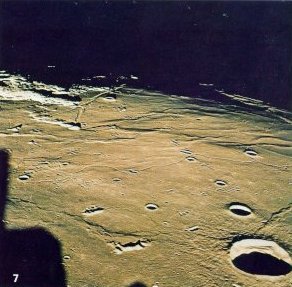
ARMSTRONG:
This is the view of the area over which the descent trajectory passes, as was seen through the LM window during our activation (Photo 7). Maskeline crater is in the bottom right of the photo, and in the center in the bottom there is a mountain called Boot Hill. Directly above Mount Shoeboot Hill there is a small crater with a sharp edge, called Maskelyn W, which was the crater that we used to determine our inclined distance and lateral position error before completing the final descent phase.
The landing pad itself is located in a smooth area at the top of the image right before entering the shade or what is called a terminator. We saw several photos from Apollo 8 and 10, which gave us an excellent idea of the ground path over which we will pass during the descent. Now we look at the crater Maskelin W in the right window. He appeared about two to three seconds later and told us that we were likely to sit down for quite some time.
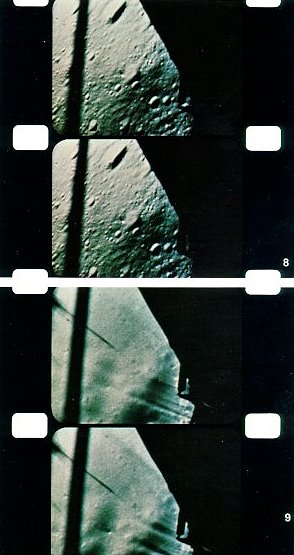
After completing these position checks, we turned upside down so that the landing radar could capture the surface and confirm our actual height. This is not visible in the picture, but on this stretch of the trajectory we looked through the window directly at planet Earth. At the final stages of the descent, after several programmed alarms, we looked at the landing zone and found a very large crater (Photo 8). The camera is located in the right window and looks to the right, it captures this field with boulders a bit over which we pass. Right now we're at 400 feet, and these boulders are about 10 feet across. This was an area in which we decided not to go; we increased the distance to the landing point and in the final phase of the descent we saw the crater we passed over - this 80-foot crater, and then took some pictures of it.
Here you can see the spread of dust raised by the engine (Photo 9), and this caused some concern because it impaired our ability to determine not only the height and altitude in the last stage of descent, but also, perhaps it was even more important. our translational speed along the surface. It is quite important not to break your finger at the last stage of planting. The dust settled immediately after landing on the surface, and we perfectly saw the area surrounding LM. This is the view from the left window. It shows a crater surface pitted with craters up to 15, 20, 30 feet and many smaller craters with a diameter of up to 1 foot, and, of course, this surface was very fine-grained (Photo 10). We could say, judging by the view from the window, that there were surprisingly many stones of all sizes.
The terminator is the sharp border of the sun's shadow on the surface of the moon. Speaking not to break a finger at the last stage of landing, Armstrong had in mind the landing support.
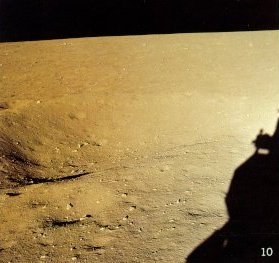
Aldrin:
This is a view from the right window (Photo 11). Closer to the horizon, you see a field of boulders that probably formed after some blows to the craters that were behind us. You see that most of the craters have rounded edges, but there is a difference in their age, as you can say, judging by the sharpness of the edge of the crater. Later we will see more pictures of the area immediately adjacent to us. It was a relatively flat area, unlike some of the more hilly areas that we could see from the front and left windows. This is a view when looking forward to where the shadow from LM falls on the surface (Photo 12), and we see a diffraction glow around the top of the LM.

The overall color of the landscape, looking from the side of the Sun, was bright golden brown. When you turn your gaze in the direction of the sun, it takes on an increasingly distinct gray shade. In the initial period of time after landing, we went through various sequences of preparation for an immediate interruption or ascent, if we found it necessary. It turned out that we should open the fuel and oxidation collectors a little earlier than we thought. We went through these various checks and prepared for the launch, which could have occurred about 21 minutes after the start of the controlled descent (i.e., about 8 minutes after landing) . The land allowed us to stay during this period, and we did not have to use it.
Then we moved on to a simulated, countdown, which consisted of checking our guidance systems. We used the gravity alignment function, where the inertial platform of the main guidance system resets the gravitational vector to determine the local vertical. Then we compared it with the alignments that we had before.
We also used the stars visible through the telescope, pointing it due to the rotation of the field of view so that the crosshairs overlap the star - this will give us angular measurements of the star in the field of view of the telescope. Then we determine the distance to it by applying another radial spiral. We applied the data averaging methods implemented in the lunar module, then downloaded this information into a computer and finished with our various spatial orientation checks.
All this was done in preparation for a possible launch, which could take place about two hours after landing, as soon as Mike and Columbia made the first turn. The ground network allowed us to stay, and we completed the checks from the rest of the checklist in our simulated countdown, after which we turned off and de-energized many systems on board the spacecraft and switched to eating.
This fragment was difficult to translate meaningfully, since Aldrin was carried away by technical details and terms that are understandable only to specialists. By aligning another radial spiral, he obviously meant the use of a pattern in the form of a logarithmic spiral, which can be seen in photo 32. Tools of this kind, which include the slide rule, were actively used by engineers at a time when electronic calculators were not there.
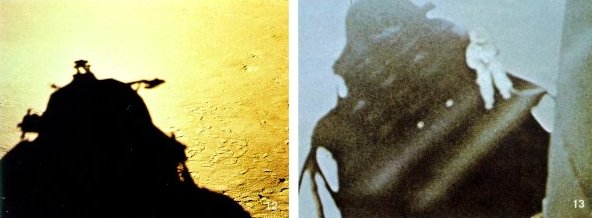
ARMSTRONG:
Before the flight, some experts predicted that people trying to work on the lunar surface might encounter great difficulties due to the many strange atmospheric and gravitational features that they would meet there. But it turned out that this is not so, and after landing we felt very comfortable in lunar gravity. In fact, this was, in our opinion, preferable to both weightlessness and terrestrial gravity. This was due to the fact that all LM systems worked perfectly - we had very few obstacles to getting started immediately on the surface. We predicted that we would be ready to leave LM by 8 o’clock, but those of you who have been following us on Earth have noticed that we have missed a lot with our assessment. This was due to several factors:
1. we had to do the cleaning (food packages, flight plans, all the items that we used in the previous descent, had to be removed from the road before depressurization of the lunar module);
2. It took more time to depressurize the lunar module than we expected and ...;
3. It also took longer than we expected to get the refrigeration units in our satchels to work.
Essentially, it took us about an hour more to get ready than we expected. When we finally went down the stairs, it turned out that it was very similar to the imitation of lunar gravity that we performed here on Earth. When descending the stairs no difficulties arose. The last step was about 3.5 feet from the surface, and we were somewhat worried that we might have difficulty returning to LM at the end of the activity period. Therefore, we trained in this before performing an exercise to lower the camera, which took subsequent pictures of the surface. Here you can see how the camera lowers on what might be called the “Brooklyn clothesline” (Photo 13).
I acted very carefully here, because right at my right, outside the picture was a crater six feet deep. And I was somewhat worried about the possible loss of balance on a steep slope.
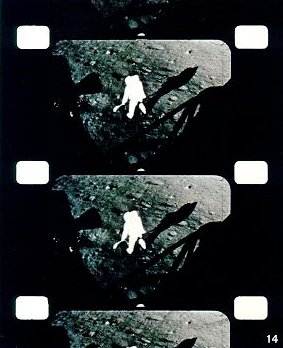
Another subject of interest in the very early stages of EVA (in case it was interrupted for some unknown reason) was the work of returning lunar rock samples. The photo shows the collection of these first samples in a small bag (photo 14), then this bag was stored in my pocket. This was the first of many cases when it turned out that two people - this is a big help. I quickly installed a television camera.
And then the more leisurely Buzz and I teamed up to raise the American flag (Photo 15). We had several occasions when we could help each other on the surface in many different ways. You probably remember the moments when my leg got entangled in a television cable, and Buzz managed to help me remove it without falling.
Under the period of activity, the Nile means staying on the surface of the moon - Extra Vehicular Activity abbreviated EVA.
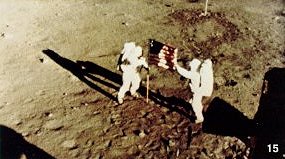
Aldrin:
At first, we had some difficulties in getting the flag post to stay on the surface. When penetrating the surface, we found that most objects will enter it by 5, maybe 6 inches, and then they will meet increasing resistance. At the same time, there was little supportive force on both sides, so we had to slightly flip the flag back so that it retained this position. So many people have done so much to give us the opportunity to put this American flag on the surface. For me, it was one of the most proud moments in my life when I could stand there and quickly salute the flag (Photo 16).
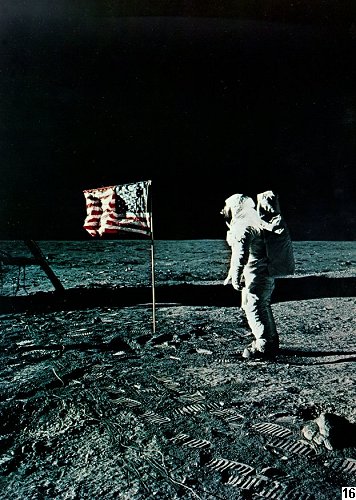
ARMSTRONG:
The rest of the activity (EVA) seemed to us very hasty. It was necessary to do a lot of things, and it was difficult for us to finish them.
Aldrin:
We found that surface mobility was generally slightly better than what we might have expected. There was a slight tendency to be closer to the back of a neutral, stable position. The loss of balance seemed to be fairly easy to identify. With a slight tilt in one direction or another, it was very easy to determine when this loss of balance was approaching. In the process of maneuvering around (the landing site) , as you can see, this was one of my tasks at an early stage of EVA.
I found that the standard technique of skipping one foot in front of the other worked as well as we expected. You could also jump more in kangaroo style, two feet at a time. It seemed to work, but without the same degree of control of your resilience as you moved forward. We found that we should have anticipated three to four steps forward compared to one or two steps forward when you walk the Earth.
ARMSTRONG:
We had very few problems on the surface, much less than expected. It was a nice operation. The temperature was not high. She was very comfortable. Little EMU (Extravehicular Mobility Unit), a combination of a spacesuit and a satchel that provided or supported our life on the surface worked great. We had no reason to worry about the operation of this equipment. The main difficulty that we observed was that we had too little time to do many things that we would like to do.
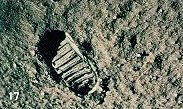
In earlier photographs, you saw stones and a field of boulders of 3 and 4 feet in size from Buzz’s window — very likely pieces of lunar, bedrock. And it would be very interesting to go through it and take some samples from them. There were other craters that varied greatly, which would be interesting to explore and photograph. We had a problem of a five year old boy in a candy store. There are too many interesting things to do. The surface, as we said, was fine-grained with lots of stones on it. She perceived the traces very well, and the traces remained in place. (Photo 17).
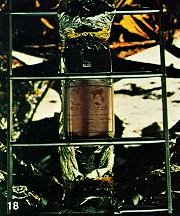
The LM was in good condition and could not see any damage from landing or descending. Here is an image of a staircase with a famous sign at the bottom (Photo 18). There was a question about whether the LM would sink to the knees. This is not as you can see. The soles of the supports sank, maybe an inch or two. And the dipstick in this image folded and stuck out through the sand in the lower right corner (Photo 19), showing that when we touched we moved a little to the side.
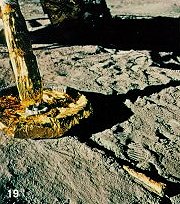
There was a wide variety of surfaces. Here Buzz stands in a small crater (Photo 20) and this gives a very good picture of its rounded edges, which we think are very old features. LM was in a relatively smooth area between the craters and the boulder field (Photo 21). And we had some difficulty in pinpointing what was right up and down. Our ability to choose directions straight up and down was probably a few degrees less accurate than here on Earth. And this caused certain difficulties for things like our cameras and scientific experiments to maintain the level of position that we expected.
Astronauts called instruments for conducting experiments as scientific experiments.
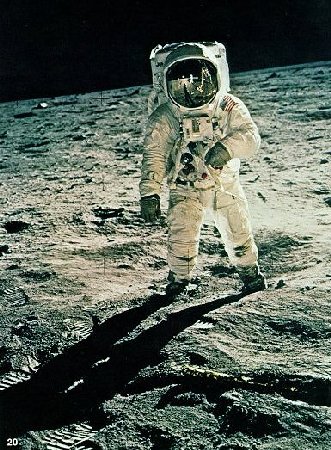
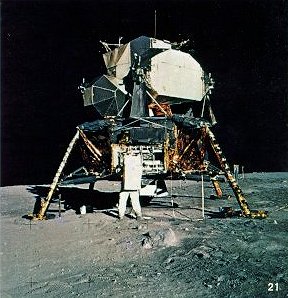
Aldrin:
Those two experiments that you saw in the previous picture were deployed in the compartment of scientific equipment. We found that lowering them did not cause significant problems. And here you see how I transferred these two experiments to the deployment site (Photo 22), about 70 feet south of the lunar module. You see very well how the depth of the upper surface layer changes. You see that along the edge of the crater - the edge of a small crater to my left - along this the upper surface seems to be 2 to 3 inches (depth). The subsurface layer has a slope that is poorly defined, and you need to be very careful when walking around these very small craters. I think that any long excursions would require considerable attention when traveling,
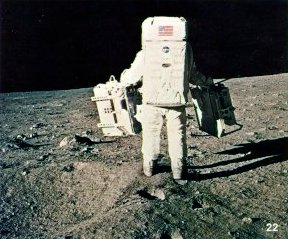
This is a Passive Seismic Experiment (Photo 23), which was deployed and gave us good reports on the interactions of the Moon (with bodies falling on it) .
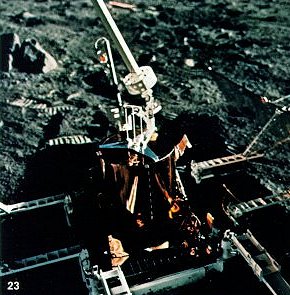
We had a little difficulty deploying one of these panels. I had to go around it on the far side and release the holding lever, and then the second panel came out. We had little difficulty in determining, as Neal said, the exact local horizontal, and I think this is due to a decrease in the signals that a person receives regarding which direction actually goes up. You need to lean a little more to the side before you receive a signal from the body that you are approaching a loss of balance, and, of course, the landscape in this area varied significantly.
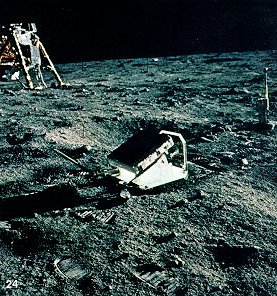
This second experiment is the Laser Reflector (Photo 24).
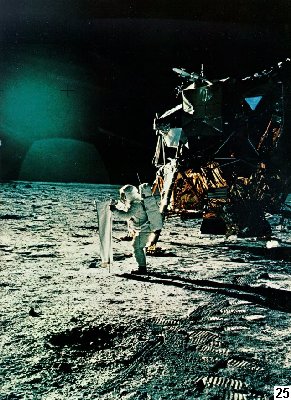
We have succeeded in reflecting laser beams from this; it consists of an array of hundreds of corner reflectors. You can see that another experiment, the Solar Wind Experiment (Photo 25), was deployed quite early in flight and was already collapsed. Just one of the last things before I entered LM again. In this picture you see how I inject the core into the surface (Photo 26). We collected two different core samples. It was quite surprising - the resistance that we met in this subsurface environment, and at the same time you see that it did not support the core very well when I drove it to the surface.
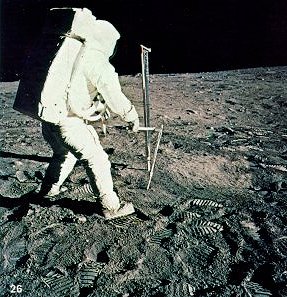
ARMSTRONG:
This is a double photograph close up (Photo 27). In fact, this is a stereo image of finely dispersed material on the moon. It is taken from a depth of about one to two inches from the surface and shows a shiny coating on some lumps there. It looks like molten glass, and analyzing the cause of this feature is extremely interesting for the scientific community.
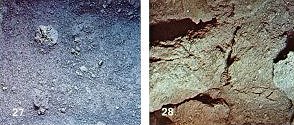
The second shot taken by this scientific camera shows the nature of the lumps of lunar surface material (photo 28), and this photo shows the 80-foot crater that you previously observed in the film during the final descent phase (photo 29). We really hoped that this crater would be deep enough to show the lunar root rock. Its depth was about 15 or 20 feet, and although there are stones at the bottom, there are no signs or images of lunar rock on the inner walls.

Aldrin:
We left several objects on the lunar surface. I am sure you know about them. One of them was a disc with 73 messages from world nations. There was the emblem of Apollo 1 and various medals from astronauts. We also decided, as a team, to place the symbol that represented our logo; that is, an American eagle carrying an olive branch to the surface of the moon. We thought it was appropriate to leave this copy of the olive branch before we left the moon.

ARMSTRONG:
After returning to LM, we could see the result of our activity on the surface (Photo 30). You will notice that in the area where most walks took place, the surface looks much darker. However, on the left side of this picture, where it is not so dark, there were also many walks. This indicates that the footsteps probably just increase your ability to notice the effects of the strange lighting that Buzz mentioned earlier when the lighting under the oncoming sunlight is slightly darker than the lighting under the sunlight falling from behind.
Aldrin:
After EVA, we had a period of sleep, which, in a word, did not go as well as we thought. It turned out that it was rather difficult to warm up. When we pulled the curtains over the windows, we found that the environment in the cabin had cooled significantly, and after about two or three hours it became clear that it was rather difficult for us to sleep. You see the 16 mm camera installed in the right window (Photo 31), which was installed for shooting on the surface.
After a period of sleep, as we were approaching the start, we started to gradually turn on the power of the lunar module, which included another check of the alignment of the stars. And when Mike passed over us in Colombia one turn before the start, we used the radar to track him as he passed. We have continued verification.
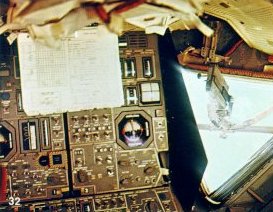
You see here, one of the data books that is installed in front of the dashboard (Photo 32), which was used to record various messages sent to us (Earth). A whole host of numbers for the various upcoming maneuvers that we copied. We recorded them on this kind of data sheet.
ARMSTRONG:
This video shows our last look at the Base of Tranquility (Photo 33) before our departure, and taking off was a great pleasure. Everything went very smoothly. We were very pleased that the engine ignited. This gave us an excellent view of our take-off path and the Base of Tranquility while we were leaving it, and during the whole climb we could choose landmarks that convinced us that we were on the right track. There were no difficulties with the climb, and we enjoyed this trip more than we could say.
Aldrin:
Both guidance systems converged very closely when we were finally put into orbit. I believe that they diverged on something like half a mile or seven tenths of a mile at the peak of the resulting orbit. After checking the alignment after entering orbit, we began to collect radar data on the relative positions between the two ships (LM take-off and Colombia) . The solution for the first sequence of rapprochement maneuvers was extremely close to the value that the Earth gave us.
An unexpected feature was that many of us expected a rather large deviation from the plane (passing through the center of the moon and the orbit of Colombia)possibly due to some azimuthal displacement on the surface. We expected somewhere, maybe up to 20 or 30 feet per second, speeds perpendicular to this plane. It turned out that we did not even have to use any special maneuver in the direction of this plane, which would be inserted between two other consecutive maneuvers. Compared to many simulator launches, it turned out to be such a perfect date that we could only ask for.
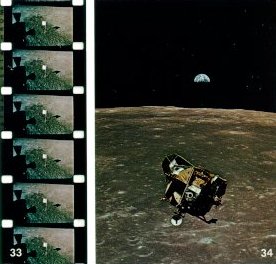
ARMSTRONG:
If some fluctuations in this film are noticeable during take-off, then this is a real feature of the aircraft, associated with a change in the center of gravity as the fuel is consumed, this creates noticeable, five-degree fluctuations throughout the take-off.
COLLINS:
This is the Eagle (Photo 34), or perhaps half of the Eagle would be better, since the landing gear and the lower part of the landing step, of course, remained on the surface. It was a very happy part of the flight for me. At this stage of the game, for the first time I really felt that we were going to do all this. Although we were far from home, we were much closer to it than the clear distance (to the Earth) could indicate .
Neil does the initial maneuvers to roll over, and then I do the final docking again. It looks a little faster than in real time. The probe is a dark funnel in the upper part of the LM, and the docking target is below it and to the left in the lighter part of the LM. As Buzz said, the meeting was absolutely beautiful. They approached from below as if traveling by rail. During the last part of the meeting, there were absolutely no problems or any unusual events.
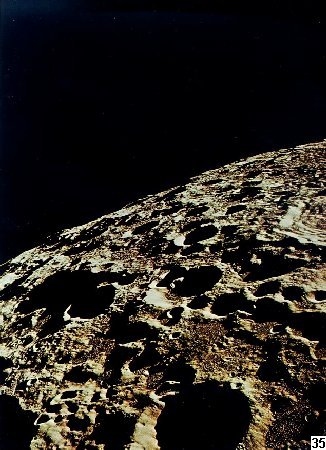
At the top right you can see RCS QUADS, and at the bottom there are various antennas and other protrusions. This gives you some idea of the roughness of the lunar landscape (Photo 35).
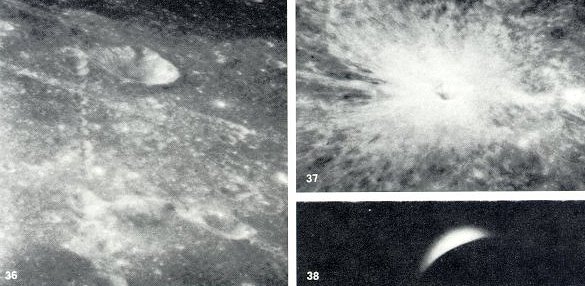
Of course, the basalt slab on the front side is smoother, but overall the back side of the moon is rather rough. I have a series of slides on which I am not going to stop to save time, but I just would like to note that we still made a certain number of pictures.
I believe that we probably made a thousand photographs from Colombia, and some of them show very interesting surface features, various types of unusual craters, and some of them pose many puzzles that, we hope, geologists will eventually be able to answer for us . This line of craters (photo 36), for example, is difficult to explain; or, at least, or at least without an argument it is (the meaning of this phrase could not be understood). Here is the nearest crater from which the white material emerged (Photo 37). And this is an image of the solar corona (Photo 38). Neal, do you want to end this?
ARMSTRONG:
During our flight to the moon, we flew through the lunar shadow, in fact the moon overshadowed the sun. We took the opportunity to try to take some of her photos, but our film was not fast enough to catch this event. However, it still shows the brightest part of the solar corona. It extends to several lunar diameters additionally on each side. They are approximately parallel to this light, but for us, as observers, the striking thing was not the solar corona, but the Moon itself (Photo 39).
Of course, it was dark and unlit by the Sun, but it was lit by the Earth, and at this relatively close distance it had an undeniable, three-dimensional effect and, undoubtedly, was one of the most impressive spectacles during the flight. When we left the moon after a successful TEI, this was the view we observed. I think that, at least at this stage of the flight, the colors that you see are pretty close to what the moon actually is, when viewed from this distance. We were sorry to see the moon disappearing, but we were certainly happy to see the return of the Earth (Photo 40).
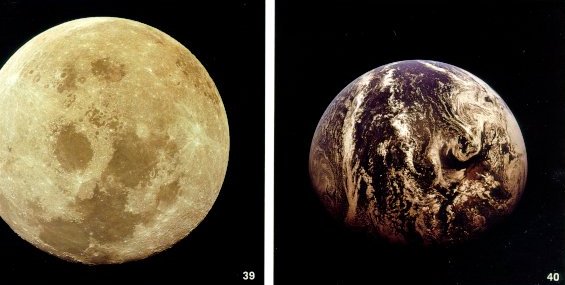
We took a large number of photographs on the way there and back, and our wristwatches were set for Houston time. This can be found in interesting applications. If you looked at this picture and glanced at your watch, and your watch showed at 7:00 p.m., then you would know that in Houston it is about 7:00 p.m., which is about an hour from sunset.
So this would be about one twenty-fourth circumference of the Earth from the shadow, which is only about 15 degrees, so at any time, looking at our wristwatch and looking at the Earth, we knew what was under the clouds. This to some extent helped us highlight what we were supposed to see. We could see a large number of details on the surface of the Earth, specifically all continents and islands and parts, many of which you may have observed in our radio communications. But we were interested to know how well we can observe the weather patterns, not only on a global scale, which you see here, but also in specific places. Specifically, this image shows the coast of North America, the equatorial layers of clouds, which, in our opinion, is probably a zone of inter-tropical conversion, and cirrus clouds over the Antarctic.
This ends the slide show, the light turns on and the astronauts move on to answering reporters' questions.
REPORTER:
How much time did you have left in your backpacks for life support when you returned aboard the lunar module?
ARMSTRONG:
I did not see the post-flight analysis of these numbers. We had about half of the available oxygen left in our satchels, and a slightly lower percentage of the water we use for cooling. Of course, especially in our first experience using this satchel on the lunar surface, we were interested in maintaining a good margin in case we had difficulty closing the hatch or restoring pressure in the lunar module, or any difficulties returning the systems inside the cabin in normal working condition.
THE REPORTER:
Colonel Aldrin and Mr. Armstrong, when President Nixon phoned you on the moon, it looked like you both suddenly stopped doing something, stood there, listened and talked to him. For a moment, it looked as if you didn’t quite understand what was going on. Was there ever such a moment on the moon when one of you was a little fascinated by what is happening?
ARMSTRONG:
About 2.5 hours. (all time staying on the moon)
REPORTER:
I would like to ask Neil Armstrong when he began to think about what he would say when he put his foot on the lunar surface, and how long he thought about it - this statement about a small step for a man, a giant leap for mankind?
ARMSTRONG:
Yes, I really thought about that. This was not improvisation, but it was not planned. It developed during the entire flight, and I decided what these words would be like while we were on the lunar surface right before leaving the lunar module.
THE REPORTER:
I would like to ask Neil Armstrong and Buzz Aldrin, and I'm not quite sure how to ask this question. When you first set foot on the moon, whether it struck you when you stepped on — that you were stepping on a piece of the Earth, or your inner sensations were something like that, did you feel like you were standing in the desert, or that it was really a different world, or how did you feel at that moment?
Aldrin:
Well, in our minds there was no question of where we were. Before that, we revolved around the moon for a while. At the same time, we experienced one sixth of G. We were lit to some degree, and we saw this lighting. However, in my case it was a completely alien situation with the frozen nature of a light and dark state, and, of course, at first we set foot on the moon in a dark, shaded area.
ARMSTRONG:
This is a frozen and weirdly different place, but it looked friendly to me and it really turned out to be friendly.
REPORTER:
Some people criticized the space program as “an inappropriate item on the list of national priorities.” I would like to ask any of the astronauts: how do you feel about space exploration as a relative priority compared to the current needs of our society and the world community as a whole?
ARMSTRONG:
Well, of course, we all acknowledge that the world is constantly faced with a wide variety of problems, and in our opinion all these problems should be addressed simultaneously. None of these areas can be neglected, and we certainly do not believe that our place is to neglect space exploration.
REPORTER:
There were many radio conversations during the flight - during the controlled descent - about program alarms and so on. I was wondering, could you describe your thoughts on this issue, how it went and what advice you could give the Apollo 12 crews and the subsequent flights regarding this part of the mission?
Aldrin:
Well, I think we understand pretty well what caused these worries. It was the fact that the computer was in the process of solving the landing problem, and at the same time we had a proximity radar in the on state, and this added an extra load to the computer. Now I do not think that people on earth or we ourselves expected this to happen.
This was not a serious software alert. She simply informed us that for a short moment the computer reached the point of software overflow or receiving too many tasks for it. The computer goes continuously through the job waiting list - one item after another. This list began to fill up and a software alarm occurred. Unfortunately, this happened when we did not want to deal with these particular problems, but wanted to be able to look out the window to determine the features (terrain) as they appeared, so that we could precisely aim. And just there, inside the landing ellipse, the computer distracted us.
The landing ellipse is the calculated area on the surface, having the shape of an ellipse, inside which the lunar module should sit.
ARMSTRONG:
At that moment there was a "fire" conversation with the computer, but we really must pay tribute to the control center in this case. These people really got out, helped us and said "go ahead." That was exactly what we wanted to hear.
REPORTER:
Gentlemen, you are going to take a few tours. I wonder what your feelings are? Is this perhaps the hardest part of the mission, or are you looking forward to it?
ARMSTRONG:
This, of course, is the part that we are least prepared to handle.
REPORTER:
What do you consider the most important advice and recommendation that you will give to the Apollo 12 crew before they go to the moon in November, gentlemen?
ARMSTRONG:
I did not hear ... the first recommendations for the 12th in what?
The question was asked with a strong foreign accent, so Armstrong did not immediately understand and the reporter had to repeat
ARMSTRONG:
I think we can say that in general we will not change the plan that we used or the plan that they intend to use. They know that there are a large number of individual details that, in our opinion, can be improved, and in the last couple of weeks we have had the opportunity to discuss these details with crew members and various people from the entire program (Apollo) . In general, I would say that we will not recommend any major changes to their flight plan.
THE REPORTER:
Will you recommend any changes to the procedures for walking on the moon and the research procedure, and are your suits mobile enough in view of these changes, or would you recommend additional mobility functions for them to work on the moon for them?
Aldrin:
Well, you can get used to the typical mobility that your suit gives you, and, of course, we would always like to have more and more dexterity when moving hands and fingers. These things are studied of course. Mission Apollo 12 will have two different EVA periods: one at the beginning of the mission, then a sleep period, and then another EVA after that. We generally looked at their plans and talked with them about the duration. We talked with them about the brief period at the beginning of their EVA to familiarize themselves with the EVA and one-sixth G environment. I don’t think we have any specific recommendations on how they should change their mission. This is a continual development of the EVA capabilities and the research they are undertaking on this mission.
THE REPORTER:
I would like to ask Colonel Aldrin if he will slightly expand his earlier comments on the need to foresee where you are going to go three or four steps forward, compared with one or two steps on Earth. Did you mean to avoid craters or deep holes or what?
Aldrin:
Well, I meant the inertia that the body has when moving at a speed of five to six miles per hour, which we thought was quite convenient. Due to the reduced gravity, your leg does not fall so often, so you must foresee and control the movements of your body, and since your leg is not on the surface for a long period of time at each step, you cannot make significant changes to the application of your power that would allow you to slow down. Thus, in general, we found that we should have anticipated three or four steps forward, and not perhaps one or two that you do on the surface of the Earth.
THE REPORTER:
You are now national heroes, and you had a couple of weeks in LRL to think about it. What are your first feelings about being heroes? Do you think this will change your life, and do you think that you may have another chance to go to the moon or are you going to be too busy being heroes?
ARMSTRONG:
Probably, in order to get an answer to this question, we may have to spend as much time as preparing for Apollo 11. At the Lunar Reception Laboratory (LRL)we had very little time for meditation. As it turned out, all this period of time we were very busy with things of the same kind that the crews of past flights did after their flights. Schedules for summarizing and compiling pilot reports, as well as compiling all the facts for use by all people, which will include this in future flights.
REPORTER:
I was struck by films and photographs by the difference in the very hostile appearance of the moon when you revolve around it or at some distance from it, and in warmer colors and relatively seemingly more friendly appearance when you are on the surface. I would like to ask Colonel Collins if he gets the same impression from the photographs, and the two of you who were on the moon, what is your impression in these areas?
COLLINS:
The moon changes character when the angle of sunlight falling on its surface changes. At very low angles of the sun, close to the terminator at dawn or dusk, it has sharp, repulsive features that you see in many photographs. On the other hand, when the Sun is closer to its zenith, at noon the Moon becomes more brown. It becomes an almost pink place - a pretty friendly place, so from dawn to noon through dusk you run through the whole gamut. At first it is very repulsive, becomes friendly, and then again becomes repulsive when the Sun disappears.
THE REPORTER:
Neal, did you have the feeling that you have little fuel when landing? At that moment, were you worried about the low fuel supply? And the second part of this, I suppose, is for Buzz. Based on your experience, how difficult will it be to aim, accurately land on the lunar surface in future flights?
ARMSTRONG:
Yes, we were worried about the decrease in fuel supply. We have expanded the landing distance to avoid the field of boulders and craters. We used a significant percentage of our fuel supply, and were pretty close to the limit.
REPORTER:
What changes will be based on your experience?
Aldrin:
Well, I think that it requires a very accurate determination of the orbit on which the vehicle is located before it starts a controlled descent. This requires special care when providing ground tracking, because the entire descent is based on the knowledge that the earth has and places the exact coordinates of the place where the spacecraft is in the on-board computer. And it starts a few turns earlier, and then moves forward as the computer tracks the position of the ship. Therefore, during sequences such as undocking, we must be extremely careful not to distort this knowledge of exactly where it is located, because this then leads the computer to bring the lunar module to a different place than where as everyone thought, we are arriving.
This is what defines the error ellipse, where we could probably land, aiming for the center. Now the ability to be able to control where you are, requires that you can identify features (terrain) and, of course, our landing site has been chosen so that it has as few significant features as possible to give us a smoother surface. In any area like this, there are always certain distinctive features that you can highlight — certain crater patterns — to the extent that you can use them.
If the crew sees that it is not moving exactly to the planned point, then it can cause the computer to move to a slightly different place. Now this can happen in an area ranging in size from 5 to 6 thousand feet. Then, the way Neil took control of our ship to increase the distance and go beyond the large crater - the Western Crater, may be required again if identification is carried out in the vicinity of 3, 4 or 5 hundred feet (from the intended point) in order to be able to maneuver these last few seconds at about 1,000 or 2,000 feet to make an exact landing.
Thus, a lot depends on the early trajectory, the ability to then reassign (landing site) and the final, manual control.
THE REPORTER:
For Mr. Armstrong and more about landing. Have you considered at any time the possibility of interruption when you received alarms and so on?
ARMSTRONG:
Well, I think - in the simulations we have a large number of failures, and we are usually “spring-loaded” to the interrupt position, but in this case, in real flight, we were “spring-loaded” to the landing position. We were certainly going to continue the descent until we could safely do this and no longer than the software alarms showed themselves. You understand that you may have an interruption situation with which you need to do something. But our procedure at the preparation stage has always been such as to try to continue as long as possible, so that we can get around this type of problem.
Aldrin:
Throughout this period of time, the computer continued to issue control commands and operate the device as it was programmed. The only thing that was missing during this period of time was that we did not have some displays on the computer keyboard, and we had to make several entries at this time to clear this area.
Buzz meant a computer display paired with a keyboard. Its size was not enough to display all the necessary data, so the astronauts made notes on paper.
THE REPORTER:
Does the crew want to consider a mission to the moon of this kind again, or do you prefer some other mission; and secondly, I think this question was asked, but I did not receive a complete answer. How do you propose restoring some normality in your personal life in the coming years?
Aldrin:
I would like to know the answer to the last part of your question.
ARMSTRONG:
It is up to you. But I think that the landings of this type, which are currently being considered for the next few flights, correspond to the conclusions we came to as a result of our work both during landing and work on the surface. I certainly hope that we are able to explore the different types of landing sites that they hope to complete.
THE REPORTER:
I have two short questions that I would like to ask if you can. When you did this incredible moonlit walk, did you find that the surface was equally hard everywhere or were there harder and softer spots that you could detect? And secondly, when you looked at the sky, could you actually see the stars in the solar corona, despite the bright light?
Aldrin:
The first part of your question. Somewhere in flat areas, the surface did vary in thickness of penetration. The footprint penetrated half an inch or a quarter of an inch and gave a very firm answer. In other areas near the edges of these craters, we could find that the foot would sink maybe 2, 3, or 4 inches, and on the slope, of course, the various edges of the track could rise to 6 or 7 inches. And the compression of this material tends to produce a small lateral movement, since it is compacted on the material located under it. Therefore, we think that you can’t always tell, looking at the terrain, what exact resistance will be like when your foot sinks in a place of solid contact. Therefore, you need to be very careful when moving around this rough terrain.
ARMSTRONG:
We could never with our eyes see stars from the lunar surface or on the day side of the moon without looking through optics. I don’t remember which stars we could see during the time period when we photographed the solar corona.
COLLINS:
I don't remember seeing anything.
Thus, the crew of Apollo 11 clearly and unequivocally reported that they did not see the stars on the moon. Which is perfectly clear from the physical and physiological points of view. There are no grounds for conspiracy theories.
REPORTER:
Neil, you said you were a little worried about what you said about a broken finger at the touchdown point because the surface was obscured by dust. Do you see any way around this problem for future moon landings?
ARMSTRONG:
I think that the simulation that we currently have in order to ensure that the pilot understands the problem of moon landing (that is, the simulator and the various training facilities and simulators for landing on the moon that we have) will do this job quite well. In addition, I think this is just a matter of pilot experience.
THE REPORTER:
This is for Neil Armstrong. You said earlier in your presentation that Maskelyn W (the crater) appeared about three seconds later, telling you that the landing can be quite long. That was before you reached the High Gate, so it had nothing to do with maneuvering to find a suitable landing place. I wonder what would cause this delay of three seconds. Was it somehow connected with the time when you started the guided descent or what?
The High Gate, described by the reporter (High Gate), is a point at an altitude of approximately 9,000 feet at which the trajectory of the lunar module has changed its character.
ARMSTRONG:
The time we started the controlled descent was the planned time, but the question is where you are above the surface of the moon during the ignition and where this point is located, is largely determined by the long chain of previous events: tracking (for the lunar module) that took place a few turns earlier, the flight maneuvers that were carried out when checking speed control systems, undocking and the ability to accurately withstand orbit without a single removal are very far from the place where, according to the computer, you should yt at this time. And, of course, small variations in maneuvers, such as the ignition that I performed on the far side of the moon, which were not properly measured by the guidance system.
Each of these things will accumulate in the effect, which is a mistake - a position error - when ignited, and there is no way to compensate for this error until you reach the last phase of this error.
REPORTER:
Based on your own experience in space, do you or any of you feel that someday a woman will have the opportunity to become an astronaut in our space program?
ARMSTRONG:
Damn it, I hope so!
REPORTER:
I would like to go back to what Neil Armstrong said a while ago that there were so many other things that he would like to do. Be that as it may, you are behind the schedule by a significant number of minutes. Is it because the schedule for EVA was overloaded, or can we expect that all astronauts, when they first reach the moon, will enjoy and spend so much time on what you thought was (interesting) ?
ARMSTRONG:
We plead guilty to enjoyment. As Buzz mentioned earlier, we recommend starting future EVAs with a 15 or 20 minute period to get rid of such things, get used to the surface and what you see, adapt to 1/6 G when maneuvering around, and maybe early on we just included a little more (tasks) than we were able to do.
THE REPORTER:
Two questions. From where strange sounds came, including sirens and whistles during their return to Earth. I believe that the ground control requested an explanation, saying that it came from a spaceship. Secondly, I understand that although lighting at a slight angle did not cause problems when walking, when driving at high speeds, there was a problem with the timely detection of obstacles. As far as I understand, this may indicate the need to use aircraft, rather than rovers for long-distance travels on the surface of the moon. Can you explain this?
ARMSTRONG:
We are to blame again. We sent whistles and bells — we had a small tape recorder that we used to record our comments during the flight, in addition to the music during solitude hours. We thought we would share this with people from the Control Center. The angle of the Sun was less of a problem for the things you mentioned than the curvature of the Moon and local roughness. It seemed to me that it was like swimming in the ocean with 6 or 8 foot shafts and waves. In this state, you can never see very far from where you are. And this was further reinforced by the fact that lunar curvature is much more pronounced (than Earth's) .
THE REPORTER:
This is for Mr. Armstrong. Did you plan to take on semi-manual control, or was it just your descent to the Western Crater that made you do this?
ARMSTRONG:
The series of control system configurations that were used at the final stage were actually very close to what we expected to use in the normal case, regardless of the landing zone you were in. However, we spent more time in the manual control stage than we planned to find a suitable landing site.
REPORTER:
Many of us and many other people in many places have thought about the significance of this first landing on another body in space. Does each of you want to give us an assessment of what this means for all of us?
ARMSTRONG:
You do not want to try?(turning to Collins)
COLLINS:
After you.
Aldrin:
Well, I think that what this country intended to do was something that had to be done sooner or later, whether we set a specific goal or not. I believe that from the first space flights we have demonstrated the potential to carry out such missions. And again it was a matter of time before it was reached. I think that the relative ease with which we were able to fulfill our mission, which, of course, appeared after a very effective and logical sequence of flights.
I think this demonstrated that we were certainly on the right track when we committed ourselves to go to the moon. I think this means that many other problems can possibly be solved in the same way, taking the responsibility to solve them in the long run. I think that we timely launched a mission to the moon. At this stage, it may be time to think about many other missions that could be completed.
COLLINS:
For me, there are close and distant aspects of this. In the short term, I think for our country it is a technical triumph to say what it was going to do a few years ago, and then, to hell, do it exactly as we said it was going to do ... not just, perhaps, purely technical, but also a triumph of the general determination of the nation, will, economy, attention to detail, as well as thousands and one other factors that led to this. This is a short term.
In the long run, I think that we first discovered that a person has the flexibility or the ability to either walk on this planet or on some other planet, whether it be the Moon or Mars, or I don’t know where. And I am poorly prepared to assess what this may lead us to.
ARMSTRONG:
I just see it as a start. Not only this flight, but this program, which really became a very short piece of human history, an instant in history. The whole program is the beginning of a new era.
REPORTER:
Neil, how much descent fuel do you have left when you shut off?
ARMSTRONG:
My own tools would show less than 30 seconds, I think something about 15 or 20 seconds. The analysis done here on earth reveals something more than that, probably more than 30 seconds or 45. It sounds like a short time, but actually it is quite a lot.
THE REPORTER:
This is for Colonel Collins. You used a rather colorful expression when it seemed that there was some kind of problem with the docking. Could you tell us exactly what was happening at that time? You were docked, and then ...
COLLINS:
Do you mean docking in the lunar orbit, when, after the two ships came in contact, a yaw fluctuation occurred? This wobble covered, possibly 15 degrees, during a jerk with a period of one or two seconds and was not normal. None of us expected this. This was not a serious problem. All this was completed in an extra six or eight seconds.
The sequence of events is that the two ships are first held together by three locking locks, and then the gas cylinder, when ignited, starts the retraction cycle, which allows these two to be more rigidly connected using 12 strong locks located in a circle on the periphery of the tunnel. It takes six or eight seconds for this cycle, between the initial contact and retraction.
And it was during this period of time that I had a yaw fluctuation, or we had. Neil and I both took manual corrective actions to get the two ships back on a straight line. And while this was happening, the retraction cycle was successfully carried out. The latches worked and the problem was resolved.
THE REPORTER:
Two questions. Colonel Aldrin, photographs taken on the surface, your complete portrait, show clear spots of moon soil on your lap. Did you fall to the surface or kneel? And then for Mr. Armstrong: in the last few minutes before boarding, when the program alarms turned on and so on, would you go ahead and land if you did not have ground support?
Aldrin:
As far as I remember, my knees did not touch the surface at any point in time. We did not feel that we should not do this. We felt that it would be natural to do this to lift objects from the surface, but at the same time we felt that we did not want to do this unless it was absolutely necessary. We discovered quite early in the EVA that lunar material tends to adhere strongly to any part of clothing. He will fall on gloves and stay there. When you hit with your foot or hand on something, you will shake off the outer surface of this material, but significant spots will remain. I don’t know how it got to your knees.
ARMSTRONG:
None of us fell. We would continue landing until the trajectory seemed safe. And landing is possible in these conditions, although with much less confidence than when you have information from the ground, and the computer is available to you in normal mode.
REPORTER:
For Mr. Armstrong and Colonel Aldrin. Could you tell us a little more about your feelings, your reactions, your emotions over the last few hundred feet of controlled descent? Especially when you discovered that you were heading to a crater full of boulders, and you had to change the landing site.
ARMSTRONG:
Well, first of all, I’ll say that I expected that we would probably have to make some local adjustments to find a suitable landing site. I thought it was very unlikely that we would be so lucky to go down to a very smooth area, and we planned to do this (adjustment). As it turned out, of course, we did much more maneuvering near the surface than we planned to do. And the final phase was just crowded with my eyes looking out the window, and Buzz looked at the computer and the information in the booth and passed it on to me. It was a full time job.
Aldrin:
My role over the past three hundred, two hundred feet is to transmit as much information as possible available inside the cabin, in the form of height, vertical speed and forward or sideward speeds. And my role was to convey this information to Neil so that he could devote most of his attention to observation. What I could see in terms of these speeds and heights turned out to be very similar to how we performed the last two hundred and one hundred feet of landing in many of our simulations.
At this press conference ended.
